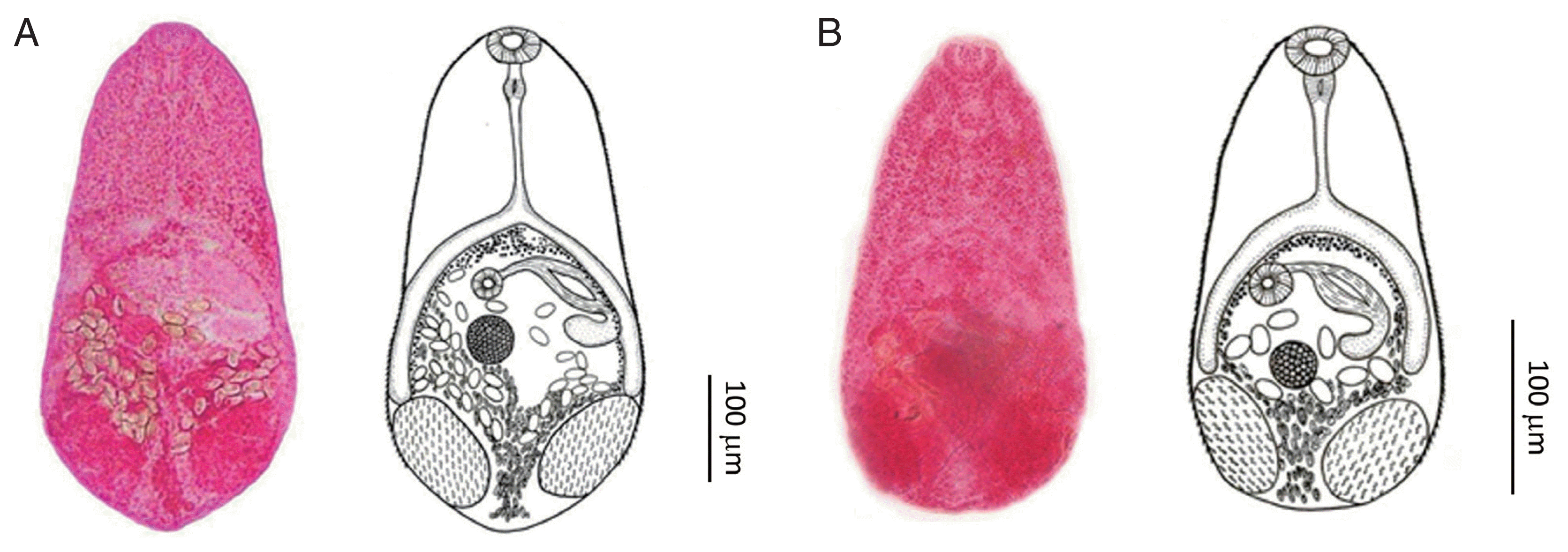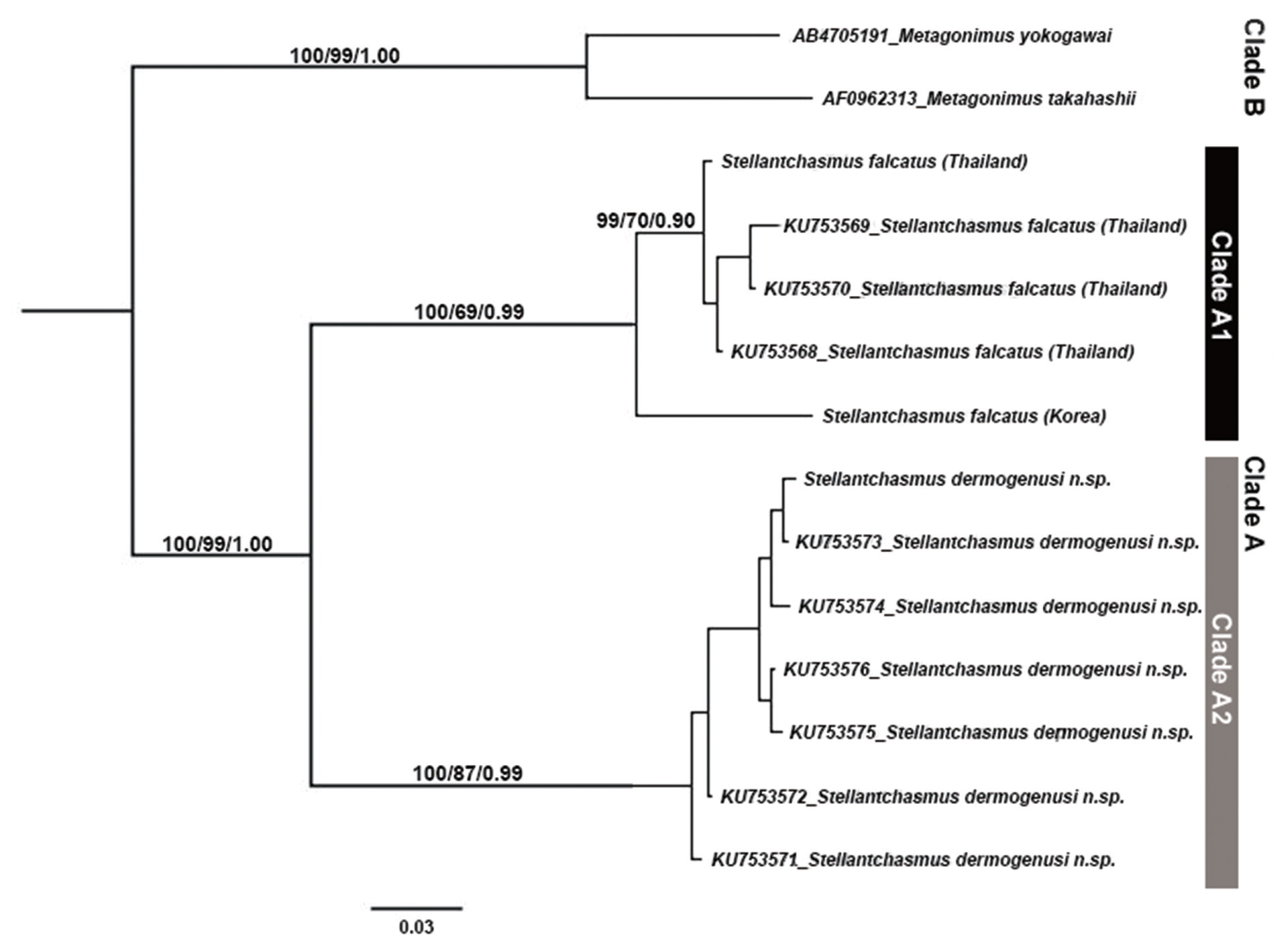1. Pearson JC, Ow-Yang CK. New species of
Haplorchis from Southeast Asia, together with keys to the
Haplorchis-group of heterophyid trematodes of the region. Southeast Asian J Trop Med Public Health 1982;13:35-60.

2. Pearson JC. A revision of the subfamily Haplorchinae Looss, 1899 (Trematoda: Heterophyidae): I. The
Haplorchis group. Parasitology 1964;54:601-676.


3. Onji Y, Nishio T. On intestinal distomes. Iji Shimbun 1916;949:589-593.
4. Seo BS, Hong ST, Chai JY, Lee SH. Studies on intestinal trematodes in Korea. VIII. A human case of
Echinostoma hortense infection. Korean J Parasitol 1983;21:219-223.

5. Kliks M, Tantachamrun T. Heterophyid (trematoda) parasites of cats in North Thailand, with notes on a human case found at necropsy. Southeast Asian J Trop Med Public Health 1974;5:547-555.

6. Sohn WM, Chai JY, Lee SH. Two cases of natural human infection by Heterophyes nocens and the infection status of heterophyid metacercariae in mullets from Samcheonpo, Kyongnam Province. Inje Med J 1989;10:443-452.
7. Tantachamrun T, Kliks M. Heterophyid infection in human ileum: report of three cases. Southeast Asian J Trop Med Public Health 1978;9:228-231.

8. Sripalwit P, Wongsawad C, Chai JY, Anuntalabhochai S, Rojanapaibul A. Investigation of
Stellantchasmus falcatus metacercariae in half-beaked fish,
Dermogenus pusillus from four districts of Chiang Mai Province, Thailand. Southeast Asian J Trop Med Public Health 2003;34:281-285.

9. Africa CM, de Leon W, Garcia EY. Visceral complications in intestinal heterophyidiasis of man. Acta Med Phil (Monographic series) 1940;1:1-32.
10. Chai JY, Sohn WM. Identification of
Stellantchasmus falcatus metacercariae encysted in mullets in Korea. Korean J Parasitol 1988;26:65-68.

11. Chuboon S, Wongsawad C. Molecular identification of larval trematodes in intermediate host from Chiang Mai, Thailand. Southeast Asian J Trop Med Public Health 2009;40:1216-1220.

12. Pubua J, Wongsawad C. Redescription of the trematode metacercariae from the mullet (Liza subviridis) and half-beak (Dermogenys pusillus). Southeast Asian J Trop Med Public Health 2007;38:106-109.
14. Georgieva S, Selbach C, Faltýnková A, Soldánová M, Sures B, Skírnisson K, Kostadinova A. New cryptic species of the “revolutum” group of
Echinostoma (Digenea: Echinostomatidae) revealed by molecular and morphological data. Parasit Vectors 2013;6:64.



15. Ho HW, Bray RA, Cutmore SC, Ward S, Cribb TH. Two new species of
Phyllodistomum Braun, 1899 (Trematoda: Gorgoderidae Looss, 1899) from Great Barrier Reef fishes. Zootaxa 2014;3779:551-562.


16. Sereno-Uribe AL, Pinacho-Pinacho CD, García-Varela M, de León GPP. Using mitochondrial and ribosomal DNA sequences to test the taxonomic validity of
Clinostomum complanatum Rudolphi, 1814 in fish-eating birds and freshwater fishes in Mexico, with the description of a new species. Parasitol Res 2013;112:2855-2870.


17. Nadler SA, DE León GP. Integrating molecular and morphological approaches for characterizing parasite cryptic species: implications for parasitology. Parasitology 2011;138:1688-1709.


18. Cable J, van Oosterhout C. The impact of parasites on the life history evolution of guppies (
Poecilia reticulata): the effects of host size on parasite virulence. Int J Parasitol 2007;37:1449-1458.


19. Huyse T, Volckaert FA. Identification of a host-associated species complex using molecular and morphometric analyses, with the description of
Gyrodactylus rugiensoides n. sp. (Gyrodactylidae, Monogenea). Int J Parasitol 2002;32:907-919.


20. Dyer NA, Ravel S, Choi KS, Darby AC, Causse S, Kapitano B, Hall MJ, Steen K, Lutumba P, Madinga J, Torr SJ, Okedi LM, Lehane MJ, Donnelly MJ. Cryptic diversity within the major trypanosomiasis vector
Glossina fuscipes revealed by molecular markers. PLoS Negl Trop Dis 2011;5:e1266.



21. Wongsawad C, Rojanapaibul A, Vanittanakom P. Surface ultrastructure of encysted metacercariae and of adult Stellantchasmus sp. (Trematoda: Heterophyidae). J Electron Microscop Soc Thailand 1997;11:19-26.
22. Wongsawad C, Wongsawad P. Molecular markers for identification of
Stellantchasmus falcatus and a phylogenic study using the HAT-RAPD method. Korean J Parasitol 2010;48:303-307.



23. Chontananarth T, Wongsawad C, Chomdej S, Krailas D, Chai JY. Molecular phylogeny of trematodes in Family Heterophyidae based on mitochondrial cytochrome
c oxidase subunit I (mCOI). Asian Pac J Trop Med 2014;7:446-450.


24. Sripalwit P, Wongsawad C, Chontananarth T, Anuntalabhochai S, Wongsawad P, Chai JY. Developmental and phylogenetic characteristics of
Stellantchasmus falcatus (Trematoda: Heterophyidae) from Thailand. Korean J Parasitol 2015;53:201-207.



25. Wongsawad C. Development of HAT-RAPD marker for detection of
Stellantchasmus falcatus infection. Southeast Asian J Trop Med Public Health 2011;42:46-52.

27. Darriba D, Taboada GL, Doallo R, Posada D. jModelTest 2: more models, new heuristics and parallel computing. Nat Methods 2012;9:772.


28. Swofford DL. PAUP*. Phylogenetic Analysis Using Parsimony (* and Other Methods). Version 4. Sunderland, USA. Sinauer Associates. 2003.
29. Guindon S, Gascuel O. A simple, fast, and accurate algorithm to estimate large phylogenies by maximum likelihood. Syst Biol 2003;52:696-704.


31. Felsenstein J. Confidence limits on phylogenies: an approach using the bootstrap. Evolution 2010;39:783-791.

33. Chai JY, Sohn WM, Na BK, Jeoung HG, Sinuon M, Socheat D.
Stellantchasmus falcatus (Digenea: Heterophyidae) in Cambodia: discovery of metacercariae in mullets and recovery of adult flukes in an experimental hamster. Korean J Parasitol 2016;54:537-541.



35. Pornruseetairatn S, Kino H, Shimazu T, Nawa Y, Scholz T, Ruangsittichai J, Saralamba NT, Thaenkham U. A molecular phylogeny of Asian species of the genus
Metagonimus (Digenea)--small intestinal flukes--based on representative Japanese populations. Parasitol Res 2016;115:1123-1130.





